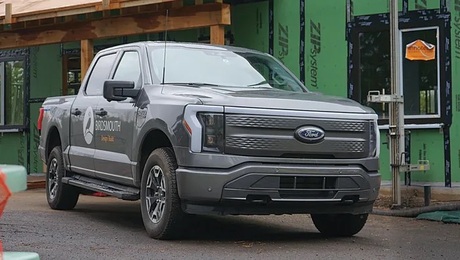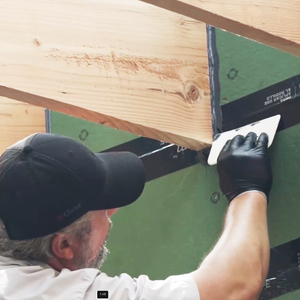Ok so I’m framing the tub surround for a bathroom remodel, in particular putting in the plumbing wall that will be one side of the tub alcove. I measure 5′ from outside wall, along each floor joist, for the area the tub will have to slide into. Problem: the resulting measurements are not a straight line! It looks like the outside wall is bowing in, not good for getting a 350lb cast iron tub to slide in. If I do a straight line for the plumbing wall, from the start of the area bounded by the plumbing wall into the tub alcove, I get about 5/16″ gap between wall and tub at the worst point; I’m told to stay within 1/8″. Perhaps I could put a small bend in the plumbing wall at the edge of the tub surround, but I plan to run DW the length of the plumbing wall (Kerdi and tiles over it for the tub surround).
Am I doing something wrong? What do the pros do?



















Replies
Get the max opening mark you need for the plumbing wall, square off the long side. Place you ledger around 3 sides. Set the tub, fur out the other end wall to straighten it and come to the proper place on the flange.
Remodeling Contractor just outside the Glass City.
Quittin' Time
Thanks for the replies. I'll run top and bottom plates perpendicular to the point where the plumbing wall should hit the back wall. I'll start the plumbing wall 3/8" wide because the stud in the corner is further in than the others, fur out some studs on the outside wall, and I should end up with 5' width by the time I reach the end of the plumbing wall.
This is definitely not paint-by-numbers. Wish the DIY books (that do suggest this is all PBN) could warn you about some of this.
That's why they call it work. DIY is the same for you as me.........only I get paid for it and bring over 30 years of beating my head against the wall with things like this. We realize quickly that nothing should be taken for granted. I might wait on the furring of the outta wack wall till the tub is set.........but then again, it's a call made on site. best of luck.Remodeling Contractor just outside the Glass City.
Quittin' Time
Believe me, point taken. I have a carpenter who is supposed to be advising me, but he's had a serious family emergency..... Thanks for the advice. The one good thing about this project has been the really excellent advice on this and another board.
Nope, TD must be before my time....
I think if I had a wider opening (certainly not narrower) to the front of the tub opening, I would wait with the furring until I had the beast set in and square to the long wall and the new plumbing wall. The ledgers would be set on all three, but I would furr the existing wall after the tub was in, using the lip as my guide. Taper the shimming into the tub area along the existing wall if it would help the flooring pattern look better, being mindfull of any jamb extensions on a window and any other thing that will come into play in the finish. And speaking of ledgers and their placement. One of the hardest things is gauging that ledger location so the tub actually sits on it w/o raising or unleveling. It's a bitch, but with pretty accurate measurements, a dry fit perhaps and a prybar, some wedges and a little luck, you'll do fine. Make sure what ever points it rests on the floor are solid, that 3-4 hundred pounds and you and the water is a bit of weight. Best of luck.Remodeling Contractor just outside the Glass City.
Quittin' Time
Thanks again. The tub does not sit on a ledger which makes it a bit easier. It sits on 4 fairly tiny feet, very concentrated point load. I (or a carpenter I found to do the job) put doubled up TJIs under each pair of feet. This weekend I need to put up the plumbing wall for the plumber next week. I expect he'll at least want the studs for fastening the water pipes. I was thinking of waiting until the tub is in to frame the studs outside the tub alcove, just put in the top and bottom plates and studs for piping. The tub does have a flange for hanging the DW over it (planning greenboard and Schluter Kerdi). So I'd fur once to bring some studs out (before/after tub installation), then fur again to bring DW out and then telegraph that down the length of the walls either side of the alcove. I plan to replace the window on the outside wall anyway, POS awning window completely inappropriate to the architecture of the house.
BTW I was thinking of putting vapor barrier around the outside wall that will be behind the tub, and also on the floor. Reason is comments by installers here about water damage behind tubs, and in fact some of the outside stud walls had to be replaced because of extensive water damage in earlier times. That may be because of tubs without flanges though. In the tiled area I'd use Ditra and Kerdi Mat to make the floor area watertight, but tiling under the tub is too drastic and would add too much dead load. Outside the tub area, Kerdi will provide a VB.
Not tiling under a footed tub is an invitation to water damage in your floor structure. The additional weight of the 15 square feet of tile (about 20-30 lbs) under there is completely inconsequential compared to the weight of the tub (350 lbs), the water (1000 lbs) and you (165 lbs).
As to the bow in your outside wall, shim or spackle the gyprock on it flat. You're talking about 3/16 of an inch here--not three inches. Two cardboard shims cut from a Cheerios box on each stud in the depressed area will take care of that....
Dinosaur
'Y-a-tu de la justice dans ce maudit monde?
the weight of the tub (350 lbs), the water (1000 lbs) and you (165 lbs).
maybe 165 lbs for you, ya skinny bastard. Some of us have more mass.
remember that flight attendent that I coffe'd with at Ft. Getty? She saw you and said, and I quote, "Speedo's are only appropriate for olympic divers, and only AT the olympics." What was she talking about?
Marine Engineer
She musta been up early that morning; Ryan and I went for a morning splash in the sea before breakfast and wore our bathing suits in deference to any other early risers. And she's right: I did used to be a diver (but not AT the Olympics). But her eyes aren't that good: I was wearing a TYR, not a Speedo. Made in Canada, don'tchaknow....
Anyway, I weigh in at 150 with lots of change in my pockets. That 165# figure came straight out of my old copy of Second Mate, Chief Mate, and Master Examination Questions--it's the average weight of a person used for calculating lifeboat capacity.
Dinosaur
'Y-a-tu de la justice dans ce maudit monde?
Well actually 3/8" to 1/2" of SLC also, over a heating cable.... Since tiles and grout are porous anyway, surely I'll get the protection from just putting down a VB (maybe 30# paper). VB would also protect the studs.
I agree that I've found plenty of evidence of water damage, but I suspect the old damage (all on the studs at the back) may have been due to a tub without a lip. The more recent damage was in front, the tub was not level and there was no caulking or expansion joint where the tub apron met the tiled floor....
Edit: Just to clarify, the tub is not clawfoot. It still has a flange for the DW to sit over (actually GB + Kerdi) and an apron on the front.
Edited 9/4/2004 6:24 am ET by Taylor
Does this tub meet an exterior wall? If it does, completely covering the insulation with something (Durock, plywood, vapor barrier) to prevent convection into the outside wall is important. That little spot where the tub hits the wall is frequently left open. Lots and lots of moisture laden air can get in here and condense, causing the rot that you speak of.
The fix is simply to make the opening a quarter inch or a half inch wider, sheathe that end with almost anything, and then proceed as you would have.
AndyArguing with a Breaktimer is like mud-wrestling a pig -- Sooner or later you find out the pig loves it.
Thanks. I was planning on foam insulation in the stud bays (unfaced XPS, to allow slow permeation of any vapor that gets back there) air-sealed with some kind of spray foam. Below the tub edge, VB across the studs up to the lip (a recent idea). Above the tub, greenboard then Kerdi over it then tiles. Don't want VB behind the DW because that'll make a "moisture sandwich" with the Kerdi. Caulk the 1/4" gap between DW/Kerdi/tiles and tub surface. I guess caulk the gap between VB and tub edge. Hope that matches with what you're suggesting.
That sounds like it should work. The key is to air seal the back of the exterior sheathing, and it sounds like you're doing that.
AndyArguing with a Breaktimer is like mud-wrestling a pig -- Sooner or later you find out the pig loves it.
You're not the son of Taylors Dad are you? I think he used to post here.Remodeling Contractor just outside the Glass City.
Quittin' Time
Just did this last week. Set tub and cut tapered shims for the wall to square it up for finished interior surface.
MES
We generally make the RO 60 1/4" so the tub will fit with a little elbow room. don't make it too tight especially with cast iron. Some will stop the wall covering at the top of the flange and fill in the gap with Durabond. Others shim the wall so the board, GWB or Tile backer, fits down on the tub. Most tubs have a flange that fits to the rough studs. We often leave the tub plumbing wall loose so adjustments can be tweaked after the tub is in place. Seems no mater how you prepare the wall, the plumber wants a stud moved or added. If the outside wall is crooked or out of square and you need to shim, you may have to shim the entire wall and deal with the extra thickness at doors and windows too. In some cases you can cheat the difference by holding one end out and the other in to divide the discrepancy. I'd keep the walls straight.
That's the fun with finish work, and remodel's even moreso. Make it perfect looking when done................if they only knew.
By the way, nice work on that post and beam.Remodeling Contractor just outside the Glass City.
Quittin' Time